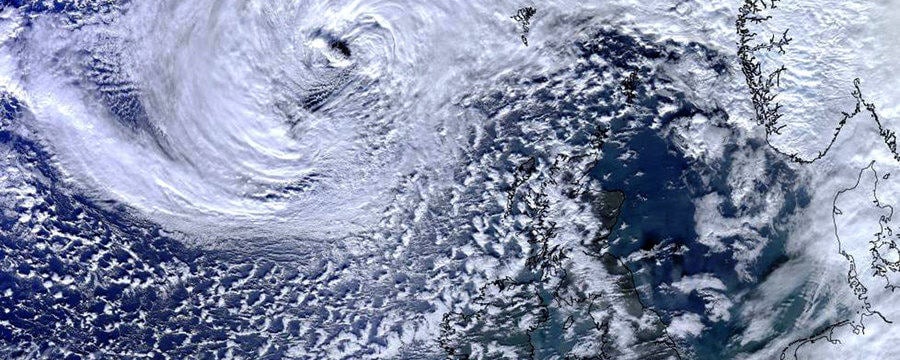Tropical Cyclones and their Development
Of all the weather systems on Earth, tropical cyclones produce some of the most intense and damaging weather. Known as Hurricanes in the Atlantic, Typhoons in the Pacific and Cyclones in the Indian Ocean, these storm systems often make the news when they make landfall in populated areas, and sometimes cause widespread devastation to homes, infrastructure and crops.
The largest losses of human life due to weather events are also associated with these systems, with death tolls sometimes into the 100’s and even 1000’s. Usually the majority of deaths occur, not whilst the system is actively affecting a region which may be for periods of less than a day, but in the aftermath as flooding and damage to the local infrastructure lead to disease, drowning and lack of a clean water supply. Figure 1 shows a satellite image of Hurricane Katrina which hit the Gulf coast of the USA near New Orleans in August 2005. This storm led to an estimated 1800 deaths mostly through disease and dehydration in the days following the storm.
Figure 1: Satellite image of Hurricane Katrina over the Gulf of Mexico, August 28th, 2005. © NASA’s Earth Observatory website
Figure 2: Diagram of a tropical cyclone.© NASA
The decay of a tropical cyclone usually occurs when the source of energy to the storm, the warm ocean surface, is removed. This may be due to the cyclone moving over land or into an ocean region with lower surface temperatures. An increase in vertical wind shear can also bring about the decay of a tropical cyclone.
The Met Office website has an informative section on tropical cyclones. This includes information on how they are named and categorised, maps of the tracks of all cyclones since 1992, notes on how the storms are forecast and links to information on how climate change may affect the formation of these systems in the future.
The Hurricane Research Division of the US National Oceanic and Atmospheric Administration (NOAA) also has a very informative FAQ on the subject.
Summary
All of the systems described here have emphasised the greater intensity of the weather patterns in the Tropics which is a response to the large amounts of energy received from the Sun at tropical latitudes.
The strong coupling between the warmest ocean surface temperatures and heaviest rainfall rates is a striking feature of the tropical climate.
El Niño is an excellent example of the coupling between tropical rainfall amounts and ocean temperatures. Shifts in the pattern of temperatures in the equatorial Pacific Ocean lead to very large changes in weather patterns, not just in the tropical Pacific but right around the world.
Monsoon climates involve distinct seasonal shifts in wind direction, which are accompanied by large changes in rainfall amounts between dry and wet seasons.
The regions which experience monsoons are landmasses situated on the poleward side of very warm equatorial oceans. Rapid heating of the landmasses during the spring and early summer exaggerates the passage of the seasonal cycle in these areas.
Tropical cyclones are highly energetic weather systems which can lead to large amounts of damage and even loss of life if they make landfall.
Cyclones convert heat energy from the warm ocean surface into mechanical energy of strong vertical and horizontal winds through a positive feedback mechanism. This involves evaporation of water from the ocean surface, condensation within clouds and strong rising motion within the clouds that in turn leads to stronger surface winds and more evaporation.
Share this
Come Rain or Shine: Understanding the Weather

Come Rain or Shine: Understanding the Weather


Reach your personal and professional goals
Unlock access to hundreds of expert online courses and degrees from top universities and educators to gain accredited qualifications and professional CV-building certificates.
Join over 18 million learners to launch, switch or build upon your career, all at your own pace, across a wide range of topic areas.
Register to receive updates
-
Create an account to receive our newsletter, course recommendations and promotions.
Register for free







